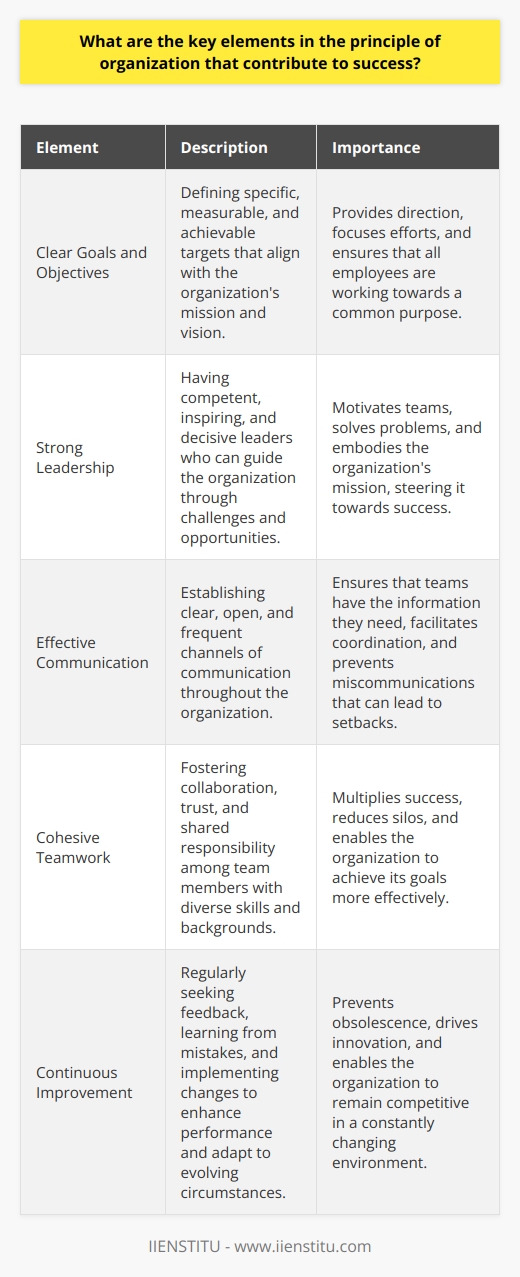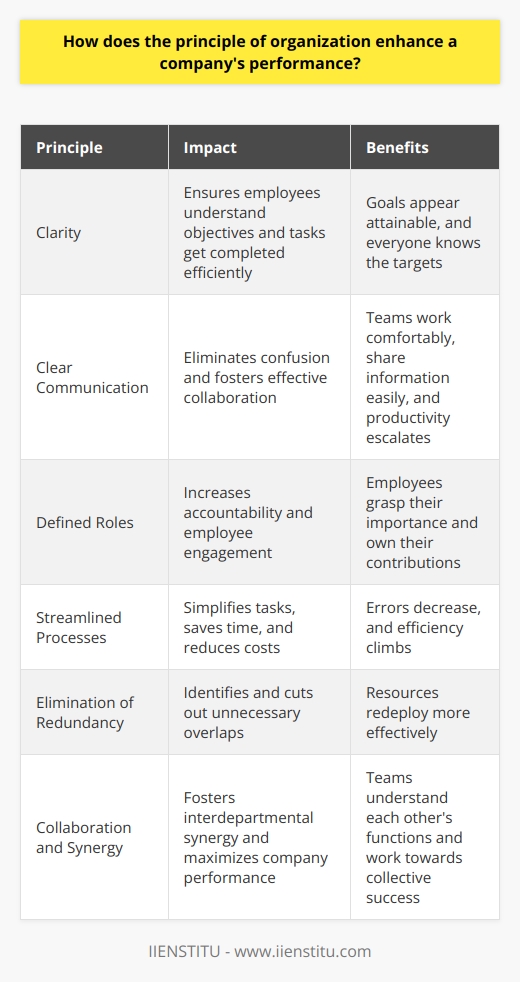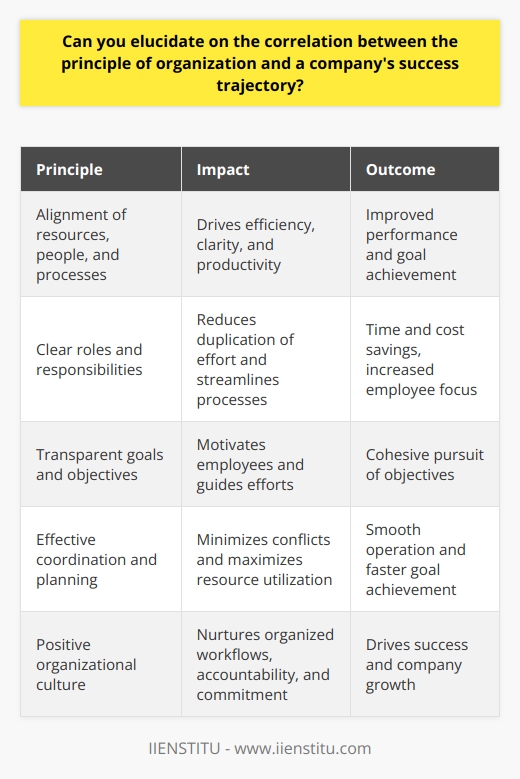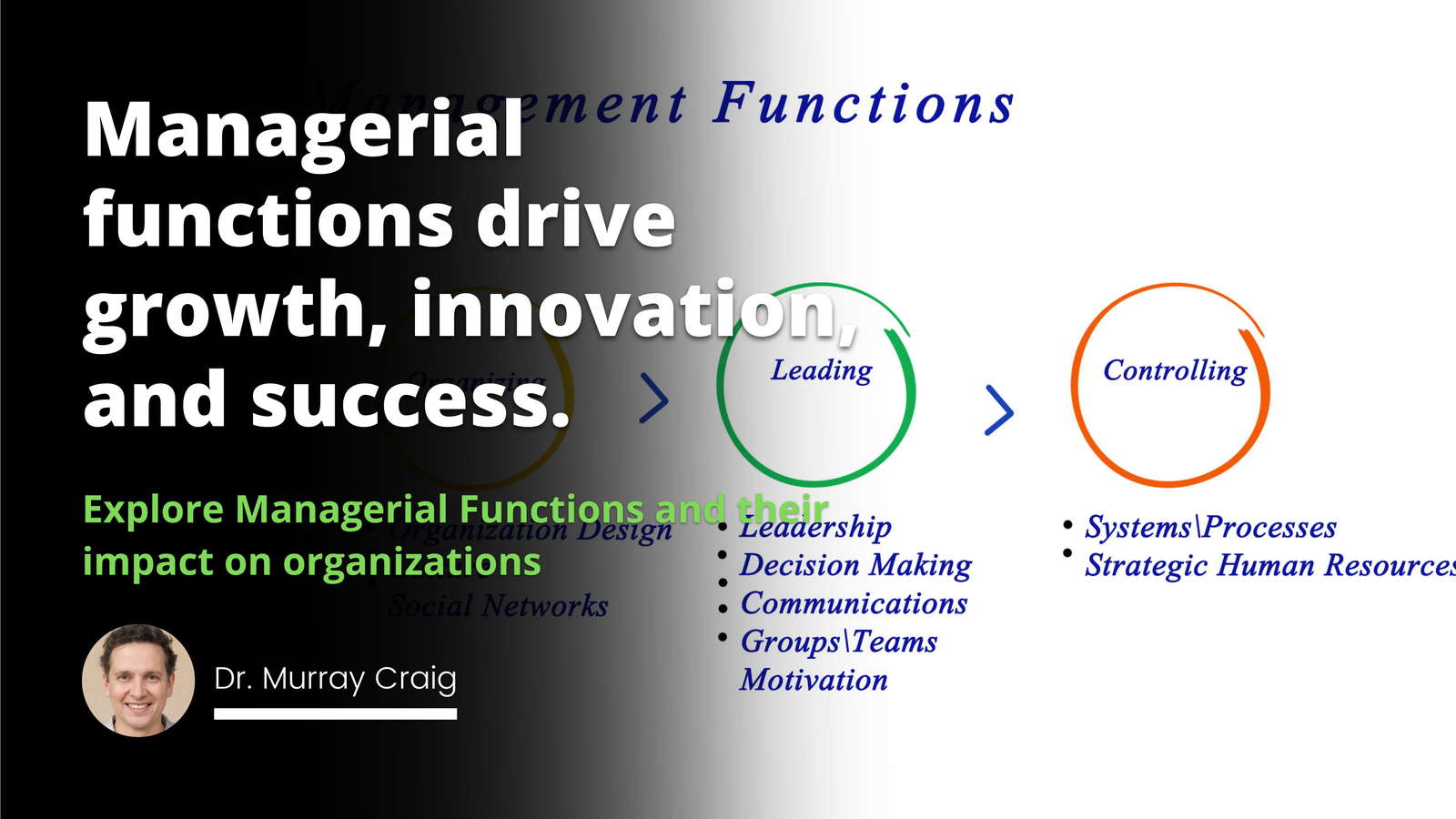
The bedrock of any successful organization lies within its meticulously crafted structure, a facet so vital that it becomes the blueprint upon which every facet of business success is built. As we delve into the complexities of organizational success, it is imperative to examine the integral components that form the Framework for Success. This very framework serves as the scaffolding for effective business management, embodying time-tested leadership principles and strategic planning for organizational success that have been known to consistently yield favorable outcomes.
From the anatomy of organizational structures to the dynamics of team leadership and the formulation of adept business strategies, this article aims to unfold the layers that constitute the principles of organization essential for success. Throughout my career, I have had the privilege of witnessing firsthand the transformative power of well-designed organizational structures. I recall my time at a multinational corporation where a shift from a hierarchical to a more flat structure unleashed a wave of innovation and collaboration that propelled the company to new heights.
The Cornerstone of Organizational Structure
------------------------------------------
The essence of organizational structure is embedded in its inherent ability to facilitate order, foster accountability, and streamline operations. At its core lie the foundational elements of hierarchy, departmentalization, and the delineation of job roles. An astutely defined structure not only simplifies the chain of command but also augments the efficiency of decision-making processes.
The congruence between structure and business objectives cannot be overstated. The manifestation of an organizational structure ought to reflect the ambitions and vision of the entity it represents. Be it through a streamlined command chain that accelerates decision-making or a decentralized approach that empowers individual creativity, the structure cohesively interlocks with management strategies to pave the path towards organizational goals.
Hierarchical vs. Flat Organizations
-----------------------------------
When it comes to organizational design, the dichotomy between hierarchical and flat structures presents a notable contrast in business management philosophy. Hierarchical models, with their distinct levels of authority, tend to exemplify clarity in responsibility and a well-defined supervisory framework. Conversely, flat organizations champion a reduced level of bureaucracy, lean communication paths, and heightened employee involvement in decision-making, albeit at the risk of potential ambiguities in role definitions and responsibilities.
The benefits of hierarchical vs flat organizations are multifaceted. Hierarchical structures can foster motivation and ambition within the ranks through streamlined command and clear-cut career progression pathways. However, the rigid nature can sometimes impede flexibility and innovation. On the other hand, flat organizations can engender agility and swift adaptation to market changes but may struggle with the absence of defined leadership during rapid scaling or complex decision-making scenarios.
The Role of Departmentalization
------------------------------
The segmentation of an enterprise into distinct functional areas or departments is a critical strategic choice that impacts both operations and organizational efficacy. Departmentalization can take on various forms, including functional, product, geographic, or process-based structures, each providing unique advantages and challenges depending on the organizational context and objectives.
The importance of departmentalization in organizations cannot be understated. Functional departmentalization, grouped by activity specialization, boasts efficiency through the concentration of expertise, yet, may silo departments leading to potential communication challenges. Product and geographic structures align tasks with specific products or regions, optimal for organizations with diverse product lines or a global footprint, yet necessitating a sophisticated coordination system. Process-based models, which are organized around the workflow, present ease in performance assessment but necessitate agility in process updates to remain competitive.
Leadership Principles Guiding Organizational Framework
-----------------------------------------------------
The architecture of an organization's framework is an embodiment of its leadership's vision and philosophy. Leadership principles for business success serve as the cornerstone and inspirational force that direct the cultural and structural arrangement within the organization, with the objective of fostering an environment conducive to success.
In assuming the mantle of stewardship, leaders must be the custodians of the organizational structure, ensuring that it not only reflects current aspirations but is also malleable enough to adapt to future challenges. This process involves a deep understanding of the organization's core competencies and the strategic foresight to align resources accordingly.
Visionary Leadership for Organizational Success
----------------------------------------------
A visionary leader is more than just a figurehead; they are the navigators who chart the course of the enterprise towards unexplored waters. Establishing a compelling vision provides a sense of purpose and direction for the organization, acting as the guiding light for all strategic endeavors. It is through this vision that a framework for successful organizations takes shape, integrating the dreams and aspirations of the organization into a tangible structure.
The propagation of this vision throughout the organization is critical, as it serves as the foundation upon which employees align their efforts. Through consistent communication and demonstration of commitment to the vision, leaders can engender a shared understanding and commitment that permeates through the organizational hierarchy.
Leading by Example: Building a Success-Oriented Culture
-------------------------------------------------------
Leadership is as much about behavior and action as it is about strategy and vision. Leaders who embody the values, ethics, and drive for success implicitly cultivate a culture that echoes these traits. By leading by example, leaders set a precedent and establish a performance-based culture reinforced by their own actions.
This principle extends beyond personal conduct; it enshrines the habit of excellence and sets high expectations that become the norm within the organization. A culture that celebrates success, rewards achievement, and learns from setbacks, while guided by exemplary leadership, becomes a deeply ingrained part of the organizational fabric.
Business Management Tactics within the Organizational Framework
---------------------------------------------------------------
The application of strategic management tactics is intricately woven into the fabric of the organizational structure. Such tactics are pivotal in ensuring that the business remains aligned with its overarching strategy while navigating the complexities of market dynamics.
Business management encompasses a broad spectrum, from tactical day-to-day operations to long-term strategic planning. Across this spectrum, the tactics employed must be congruent with the organizational structure to optimize performance and maintain a seamless operational flow.
Strategic Planning and Organizational Alignment
-----------------------------------------------
Strategic planning is the compass by which a company navigates the future. The process involves defining long-term objectives, identifying potential challenges, and formulating actionable plans to achieve desired outcomes. A critical aspect of this planning is ensuring that it is in harmony with the organization's structure, leveraging its strengths, and addressing its vulnerabilities.
Aligning strategy with structure can mean the difference between a well-oiled machine and a disjointed entity. It demands a thorough understanding of both the internal and external environments through SWOT analysis (Strengths, Weaknesses, Opportunities, Threats) and the astute implementation of plans that capitalize on organizational structure success strategies.
Resource Allocation and Optimization
------------------------------------
A key tenet of management is the judicious distribution and utilization of resources to maximize return on investment. In the context of an organizational framework, resource allocation in organizational framework demands a strategic approach that aligns with the company's priorities and structure.
By optimizing resource allocation, an organization can ensure that its departments and teams are equipped with the necessary tools and assets to execute their responsibilities effectively. This strategic maneuvering of resources, from financial capital to human talent, must be conducted with an eye towards efficiency, sustainability, and value creation.
Tailoring Strategies for Organizational Success
-----------------------------------------------
As the business landscape evolves, so too must the frameworks that underpin organizational success. A static structure in a dynamic environment is a recipe for obsolescence; hence, adaptability becomes the watchword for sustaining relevance and competitive advantage.
A flexible organizational framework permits the integration of varying strategies, all aimed at achieving success through different means. This agility enables the organization to respond swiftly to changes in the market, technology advancements, and shifts in consumer behavior.
Innovation as a Success Strategy
--------------------------------
Innovation stands at the forefront of strategic differentiation. With the incorporation of novel ideas, processes, or products, an organization distinguishes itself from competitors and carves a unique position within its market. Within the framework of an organization, innovation must be nurtured and embedded as a core value.
An innovative mindset must permeate through leadership and reach all organizational tiers, prompting a continual search for improvement and advancement. By fostering innovative strategies for business growth, not only does the organization achieve growth, but it also stimulates a vibrant, forward-thinking culture that can propel the organization to new heights.
Agile Methodology in Organization and Management
------------------------------------------------
Agility in business is a response to the complex, fast-paced nature of modern markets. The adoption of agile methodology for effective management emphasizes adaptability, cross-functional collaboration, and incremental progress towards organizational goals.
Agile practices acknowledge the reality that long-term plans may require adjustments, and therefore, promote a culture of continuous learning and iterative development. By embracing agile principles, organizations can maintain a dynamic equilibrium between steadfastness to core strategies and the flexibility needed to capitalize on emergent opportunities.
Case Studies: Frameworks behind Successful Organizations
--------------------------------------------------------
The theoretical principles of organizational structure and management come to life in the diverse experiences of industry-leading companies. Several case studies reveal the efficacy of well-implemented frameworks that are uniquely tailored to the strategic visions these organizations pursue.
Take, for example, the case of Google, a company renowned for its innovative culture and flat organizational structure. Google's success can be attributed to its ability to foster creativity and collaboration among its employees, a feat achieved through its open office spaces, cross-functional teams, and a strong emphasis on employee autonomy (Garvin, 2013).
Another notable example is Toyota, a company that has long been lauded for its lean manufacturing practices and continuous improvement philosophy. Toyota's organizational structure is designed to support its Toyota Production System (TPS), which emphasizes waste reduction, quality control, and employee empowerment (Liker, 2004). By aligning its structure with its operational philosophy, Toyota has been able to achieve remarkable efficiency and quality in its manufacturing processes.
Enhancing Communication in Organizational Structure
---------------------------------------------------
Effective communication is the lifeblood of any organization, and its importance cannot be overstated. Enhancing communication in organizational structure is a critical aspect of ensuring that information flows smoothly across all levels of the organization, fostering collaboration, coordination, and timely decision-making.
One strategy for improving communication is to establish clear channels and protocols for information sharing. This can involve regular team meetings, open-door policies, and the use of collaborative tools and platforms. By providing employees with the means and opportunities to communicate effectively, organizations can break down silos, encourage cross-functional collaboration, and promote a culture of transparency and trust.
Throughout this discourse on organizational structure and its pivotal role in achieving business success, we have navigated the intricacies of the Framework for Success. The interplay between organizational structure, leadership principles, and business management tactics emerges as a complex yet elegantly orchestrated mechanism that facilitates organizational success.
Reflecting on this, businesses must reevaluate their own structures and principles, continuously refining their framework to uphold and expand their success. Leaders, managers, and teams alike must converge in their efforts, imbued with the understanding that the organization's framework is not merely an abstract concept, but the very essence of its potential for greatness.
Through this examination, questions, and narratives pertaining to the principles of organization may have surfaced among readers. I invite you to share your experiences or inquiries in the comments, stoking discussion and fostering a collective pursuit of success. Let us continue the journey of learning and growing together.
References
----------
Garvin, D. A. (2013). How Google sold its engineers on management. Harvard Business Review, 91(12), 74-82.
Liker, J. K. (2004). The Toyota way: 14 management principles from the world's greatest manufacturer. McGraw-Hill.
Mintzberg, H. (1979). The structuring of organizations: A synthesis of the research. Prentice-Hall.
Frequently Asked Questions
What are the key elements in the principle of organization that contribute to success?
Understanding Organizational Principles
Organizational principles guide companies. They offer frameworks. Success depends on them. Key elements matter greatly.
Clear Goals and Objectives
Success begins with clarity. Organizations need clear goals. Objectives align efforts. They provide direction. Employees need this. It ensures focused work. Targets become achievable. Without clarity, chaos ensues.
Strong Leadership
Leadership steers the ship. Good leaders are crucial. They motivate teams. They solve problems. Leaders provide vision. Their guidance is essential. They embody the mission.
Effective Communication
Communication binds the organization. It must be clear. Openness is key. So is frequency. Teams require information. Managers coordinate through communication. Miscommunications spell disaster.
Cohesive Teamwork
Teams drive operations. Cohesion is vital. Members must collaborate. Diverse skills are united. Goals are shared. Teamwork multiplies success. It reduces silos.
Adaptability
Change is constant. Organizations must adapt. Flexibility enables survival. It nurtures innovation. Adaptability is an asset. Rigidity hinders progression.
Efficient Systems and Processes
Systems underpin function. Processes determine efficiency. They need design. They require refinement. Efficiency saves resources. It enhances performance.
Continuous Improvement
Resting leads to obsolescence. Improvement must be continuous. Feedback fuels this. It should be regular. Lessons become stepping stones. They drive evolution.
Decision-Making Abilities
Decisions matter greatly. They should be timely. They must be informed. Good judgment is essential. It demands critical thinking.
Resource Management
Resources are finite. Effective management is mandatory. It involves planning. It includes budgeting. Resource optimization is key. Waste detracts from success.
These elements interlock. Together, they forge strong organizations. Each contributes to success. Mastery of these enables growth. Discipline integrates them into culture. Organizations thrive as a result.

How does the principle of organization enhance a company's performance?
Understanding Organizational Principles
Effective organization drives performance. It is the backbone of a company. Managers often overlook this fundamental concept. They shouldn't. A robust organizational framework empowers employees. It streamlines processes. It clarifies roles and responsibilities.
The Role of Clarity
Clarity is essential. It ensures that employees understand objectives. Tasks get completed efficiently. Goals appear attainable. Everyone knows the targets.
Clear Communication
Clear communication eliminates confusion. It fosters effective collaboration. Teams work comfortably. They share information easily. Productivity escalates.
Defined Roles
Roles must be distinct. When they are, accountability increases. Employees grasp their importance. They own their contributions. It strengthens their engagement.
Streamlined Processes
Simplicity aids function. Complex processes often lead to errors. Simplifying tasks saves time. It also reduces costs. Errors decrease. Efficiency climbs.
Elimination of Redundancy
Redundancy wastes resources. Effective organization identifies unnecessary overlaps. It cuts them out. Resources redeploy more effectively.
Agility in Management
Simplified processes enable quicker decisions. Management responds faster to changes. Adaptability becomes an operational norm.
Collaboration and Synergy
Teams must understand each other's functions. This understanding fosters interdepartmental synergy. It maximizes the company’s performance.
Cross-functional Teams
Cross-functional teams blend diverse skills. They solve complex problems better. They innovate more. Company growth often accelerates.
Shared Goals
When goals align, collaboration strengthens. Teams focus on collective success. Individual achievements contribute to company milestones.
Allocation of Resources
Resources are finite. Effective organization optimizes their use. Every asset works towards company goals.
Prioritization
Important tasks get resources first. Prioritization prevents resource waste. Companies meet strategic objectives more readily.
Leveraging Strengths
Organizations must play to strengths. Assign tasks to capable hands. Results will improve. Teams will feel validated.
The Impact of Technology
Technology revolutionizes organization. It offers tools for better management. Workflows become more refined.
Data-Driven Decisions
Data informs decision-making. It makes organizing scientifically grounded. Real-time data ensures relevant action.
Automation
Automation streamlines routine tasks. It frees up human talent. Employees then tackle more complex challenges.
Organization enhances company performance significantly. It brings clarity, efficiency, and collaborative strength. It ensures the best use of every resource. It enables agility and fosters innovation. A well-organized company consistently outperforms its competitors. It is more adaptive, resilient, and successful. Organization is not an option. It is a cornerstone for excellence.

Can you elucidate on the correlation between the principle of organization and a company's success trajectory?
Understanding the Principle of Organization
The principle of organization is vital. It encompasses structure, coordination, and management. A well-organized company aligns resources, people, and processes. Such alignment drives efficiency, clarity, and productivity.
Organization Drives Efficiency
Efficiency stems from effective organization. Clear roles emerge. Duplication of effort reduces. Streamlined processes result. Therefore, time saves and costs cut. Employees focus. Tasks complete faster. Performance improves.
Clarity in Mission and Objectives
Clear organizational structures communicate purpose. Goals become transparent. Each employee understands their contribution. This clarity motivates. It guides. It aligns efforts. Result: cohesive pursuit of objectives.
Productivity Through Coordination
Coordination is key in organizations. It requires meticulous planning. Effective systems are necessary. Coordination ensures smooth operation. It minimizes conflicts. It maximizes resource utilization. Teams work as units. Goals are achieved sooner.
The Success Trajectory
A company's success relies on organization. Good organization fosters growth. It enables adaptation. Market changes are met with agility. Innovation thrives in organized settings. Customer satisfaction increases. Revenues grow.
Organization scales with the company. Early-stage companies benefit from flexibility. Mature companies require stricter structures. Both stages need clear organization. Without it, chaos ensues.
Organizational Culture and Success
Culture influences organization. It shapes attitudes and behaviors. A positive culture nurtures organized workflows. It endorses accountability. It promotes commitment. Together, they drive success upwards.
In conclusion, organization is pivotal. It correlates directly with success. Without it, companies falter. With it, they flourish. The evidence is clear. The path is defined. Organization equals success.



